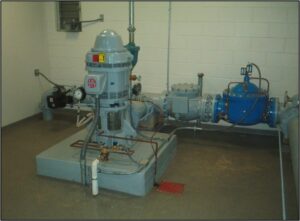How to Keep Your Groundwater Supply Reliable
Written by:
John Collins, P.E., LEED AP | Vice President & Water Resources Discipline Director
Karen Benson, P.G. | Water Resources Practice Leader & Hydrogeologist
H2M’s John Collins, P.E., LEED AP, and Karen Benson, P.G., recently presented on the topic of groundwater at the 2024 Annual Technical Conference and Vendor Exposition hosted by the Connecticut Section of the American Water Works Association. The following article is based on that presentation.
Groundwater is one of the most important renewable resource we have. According to the National Ground Water Association, nearly 40% of Americans rely on wells to supply drinking water, contributing to the 82.3 billion gallons per day pumped from the ground in the United States for drinking as well as irrigation, manufacturing, thermoelectric generation, and more.
Our collective reliance on this resources is one of the many reasons it is so imperative to monitor the safety and accessibility of our groundwater supply. Like any asset, problems can arise with either the well, the pump, or both. Knowing how to proactively identify and remedy these potential issues is vital to ensuring a steady groundwater supply to meet current and future demands.
What Are the Types of Wells?
Wells typically fall into two categories: bedrock wells and screened wells. Bedrock wells are constructed by drilling from the ground surface into competent bedrock setting solid pipe casing, and then drilling an open borehole below the casing. The capacity of bedrock wells is typically dependent on the intersection of fractures or the flow along bedding planes.
Screened wells are generally constructed in unconsolidated materials that can be found along coasts or in valleys that filled as glaciers melted. These wells use a screen assembly designed to hold back sediment and maximize flow. Unlike bedrock wells, groundwater flow from these aquifers can be more predictable. Wells completed in valley-fill aquifers may be limited by the extent of the materials, and water quality can be influenced by surface water.
Regardless, though there are different styles of well, both bedrock and screened wells require routine assessment and maintenance and require the same level of attention to keep them operating efficiently.

A standard large production well
Problems Faced When Managing Wells
Water well issues can manifest in a wide variety of ways, including the loss of capacity, pumping inefficiency, water discoloration, and overall poor water quality. These issues can be caused by water chemistry, the presence of bacteria, the design or age of the well, and how frequently it is used.
There are several methods of rehabilitation that can be performed to remedy these issues. The chosen method is typically based on the well construction and the nature of the well’s degradation.
First and foremost, a baseline well test and downhole video inspection is performed to check for the general condition of the well, and any damage, degradation, or breaches in its casing, screen, or borehole. The inspection may be followed by the application of mechanical rehabilitation techniques such as brushing, jetting, or surging.
If necessary, chemical rehabilitation methods may be used to restore the well’s efficiency. Chlorine, for example, can be used for disinfection, while mineral and organic acids may be introduced to dissolve mineral precipitates in the well.
Following the completion of mechanical and/or chemical rehabilitation, the well is retested and reinspected to determine if the rehabilitation was successful.
Well rehabilitation costs are minimal compared to the cost of replacing an existing well with a brand-new one, but like any asset, wells should be closely monitored for signs of degradation. Rehabilitation is still an intensive process, so proactive cost planning is best.
Problems with Water Pumps
Damaged or otherwise ineffective water pumps can reduce operating efficiency, increase the cost of pumping, and even pose a danger to equipment operators.
Reduced capacity, for example, is a common problem in water pumps that can be caused by anything from a damaged impeller to a hole in the casing. If unaddressed, these conditions could cause irreparable damage to the pump and lead to significant costs.
Reduced capacity is just one of many indicators that a pump may be damaged. Other warning signs include noise, vibration, changes in operating efficiency, changes in head pressure, an overheated motor, or cracking of the pump base. These are all symptoms of a broad assortment of conditions.
Knowing the common signs of a faulty water pump can save time and money when diagnosing problems before they become too disruptive or expensive to fix.
Avoid Problems Before They Begin
Thorough and regular maintenance of water wells and relevant equipment is an essential part of maintaining a reliable groundwater supply.
Water wells should undergo annual inspections to ensure peak functionality. These inspections should, at minimum, consist of a visual examination of the well, equipment inspections including the exercising of valves and electrical testing, and water quality testing.
Routine well and pump performance tests are also a necessity. Recording non-pumping water levels and conducting short tests to determine the well’s current yield, pumping water level, and pump pressure to compare to historical information will provide a good tracking system to assess issues.
All of this necessitates meticulous recordkeeping of operations data, which can help provide a performance baseline to serve as a point of reference for any abnormalities.
By being cognizant of what can go wrong with a water well and regularly looking for signs of impending problems, operators can ensure that their wells provide a consistent, healthy, and reliable supply of groundwater.
